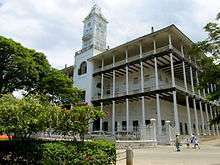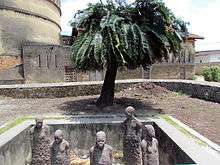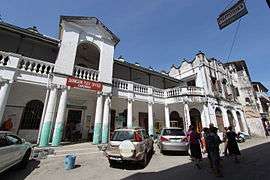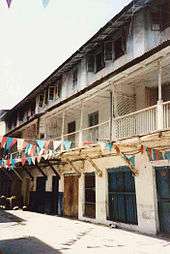Stone Town
| Stone Town of Zanzibar | |
|---|---|
| Name as inscribed on the World Heritage List | |
 | |
| Type | Cultural |
| Criteria | ii, iii, vi |
| Reference | 173 |
| UNESCO region | Africa |
| Inscription history | |
| Inscription | 2000 (24th Session) |
 Location of Stone Town in Tanzania. | |
Stone Town, also known as Mji Mkongwe (Swahili for "old town"), is the old part of Zanzibar City, the main city of Zanzibar, in Tanzania. (The newer portion of the city is known as Ng'ambo, Swahili for 'the other side'). Stone Town is located on the western coast of Unguja, the main island of the Zanzibar Archipelago. Former capital of the Zanzibar Sultanate, and flourishing centre of the spice trade as well as the slave trade in the 19th century, it retained its importance as the main city of Zanzibar during the period of the British protectorate.[1] When Tanganyika and Zanzibar joined each other to form the United Republic of Tanzania, Zanzibar kept a semi-autonomous status, with Stone Town as its local government seat.
Stone Town is a city of prominent historical and artistic importance in East Africa. Its architecture, mostly dating back to the 19th century, reflects the diverse influences underlying the Swahili culture, with the East African culture being preeminent, there is a unique mixture of Arab, Persian, Indian and European elements. For this reason, the town was designated as a UNESCO World Heritage Site in 2000.[2]
Due to its heritage, Stone Town is also a major visitor attraction in Tanzania, and a large part of its economy depends on tourism-related activities.[3]
Overview

The heart of Stone Town mostly consists of a maze of narrow alleys lined by houses, shops, bazaars and mosques. Since most streets are too narrow for cars, the town is crowded with bicycles and motorbikes. The seafront has wider streets and larger, more regularly placed buildings.
Stone Town's architecture has a number of distinctive features, as a result of Arab, Persian, Indian, European, and African traditions mixing together. The name "Stone Town" comes from the ubiquitous use of coral stone as the main construction material; this stone gives the town a characteristic, reddish warm colour.[4][5] Traditional buildings have a baraza, a long stone bench along the outside walls; this is used as an elevated sidewalk if heavy rains make the streets impracticable, or otherwise as benches to sit down, rest, socialize.[6] Another key feature of most buildings is large verandas protected by carved wooden balustrades. The most well-known feature of Zanzibari houses are the finely decorated wooden doors, with rich carvings and bas-reliefs, sometimes with big brass studs of Indian tradition.[5] Two main types of doors can be distinguished: those of Indian style have rounded tops, while those in the Omani Arab style are rectangular. Carvings are often Islamic in content (for example, many consist of verses of the Qur'an), but other symbolism is occasionally used, e.g., Indian lotus flowers as emblems of prosperity.[4]
Besides having interesting architectural features in most of its houses, Stone Town is punctuated with major historical buildings, several of which are found on the seafront; these include former palaces of the sultans, fortifications, churches, mosques, and other institutional buildings.
While Stone Town was included in UNESCO's World Heritage Sites in 2000, this designation does not provide complete protection for the town's heritage. Despite the establishment of a Conservation Authority,[5] about 80% of the 1,709 buildings of Stone Town are in a deteriorating condition.[7] As coral stone is very friable, frequent maintenance is needed for most of these buildings. Some major restoration projects (especially on the seafront) have been done in recent times by the Aga Khan Trust for Culture (AKTC).
History
Sultanate of Kilwa before 1503
![]() Portuguese Empire 1503–1698
Portuguese Empire 1503–1698
![]() Sultanate of Oman 1698–1856
Sultanate of Oman 1698–1856
![]() Sultanate of Zanzibar 1856–1890
Sultanate of Zanzibar 1856–1890
![]() British Empire 1890–1963
British Empire 1890–1963
![]() Republic of Zanzibar 1964-1964
Republic of Zanzibar 1964-1964
![]() Tanzania 1964–present
Tanzania 1964–present
Omani Dominion



Stone Town is located along a natural harbour and the first Europeans to set foot on the island of Zanzibar were the Portuguese. The Portuguese ruled the island for over 2 centuries and began constructing Stone Towns first stone structure, the Old Fort.[8] However, towards the end of the 17th century the Sultanate of Oman took over the island and completed the fort to prevent future attacks. The first stone houses in Stone Town probably began to be built in the 1830s, gradually replacing an earlier fishing village around the Old Fort.[9] At the time the Sultanate of Oman controlled the Zanzibar Archipelago, Mombasa and the Swahili coast.
In 1840, Sultan Said bin Sultan moved his seat from Muscat, Oman, to Stone Town, which thus entered an era of quick development as the new capital of the Sultanate of Oman and Zanzibar. With the British outlawing the slave trade in the Indian ocean, the Sultanate's fortunes crashed. The Muscat economy was in shambles and many Omani's migrated to Zanzibar. The increase in the Arab population on the island facilitated further growth and more buildings began to spring up in the town. Furthermore, grand royal structures like the House of Wonders and the Sultan's Palace were also built. In 1861, as a consequence of a war of succession within the Omani royal family, Zanzibar and Oman were separated,4 with Zanzibar becoming an independent sultanate under Sultan Majid bin Said.[10]
In the 19th century Stone Town flourished as a trading centre. It was especially renowned for the commerce of spices (mostly cloves) and slaves. Around middle of the century, the sultanate had a close relationship with the British; David Livingstone, for example, is known to have stayed in Stone Town in 1866 while he was preparing his final expedition into the interior of East Africa.[11] In the same period, several immigrant communities from Oman, Persia and India formed as a consequence of the town's intense commercial activity. The Sultan of Zanzibar encouraged immigration of foreign traders who became very wealthy and settled in the city who brought diversity to the cities architecture.[12]
Colonial Control
In the last decades of the century, the Sultans of Zanzibar gradually lost their possessions in mainland East Africa to the German Empire and the United Kingdom. In 1890, with the Heligoland-Zanzibar Treaty, Zanzibar itself became a British protectorate.[13] In 1896, a sudden rebellion of the Zanzibari Omanis against the British rule led to the Anglo-Zanzibar War, which is remembered as the shortest war in history: the Sultan surrendered after 45 minutes of naval bombardment of Stone Town by the Royal Navy.[14]
During the period of British protection, the Sultan still retained some power and Stone Town remained a relatively important trading centre for the informal trade. Though the town previously had a small railway the British constructed a railway from the Town to Bububu village. The British did not fund major developments in the town and allowed the sultan to manage the islands affairs from stone town.[15] The British gave privileges to Mombasa and Dar es Salaam as their trading stations in East Africa.
Zanzibar Revolution
In 1964, Stone Town was the theater of the Zanzibar Revolution that caused the removal of the sultan and the birth of a socialist government led by the Afro-Shirazi Party (ASP). Over 20,000 people were killed and refugees, especially Arabs and Indians, escaped the island as a consequence of the revolution.[16] The Arabs and Indians left behind everything they had and the ASP quickly occupied old homes and converted them into public buildings. In 1964 when Tanganyika and Zanzibar combined to form Tanzania, Stone Town kept its role as a capital and government seat for Zanzibar, which was declared to be a semi-autonomous part of the new nation.
Geography
Stone Town is located roughly in the middle of the west coast of Unguja, on a small promontory protruding into the Zanzibar Channel. The closest major settlement on the Tanzanian coast, opposite to Stone Town, is Bagamoyo (to the south-west).[17] Stone Town is part of Zanzibar City, that also comprises the "New City" of Ng'ambo ("the Other Side"), which mostly extends in the interior of Unguja to the south-east. The ideal dividing line between Stone Town and Ng'ambo is Creek Road.[18]
Demographics
| Historical population | ||
|---|---|---|
| Year | Pop. | ±% |
| 1870 Est. | 10,000 | — |
| 1948 | 16,698 | +67.0% |
| 1958 | 18,179 | +8.9% |
| 1978 | 15,493 | −14.8% |
| 1988 | 15,854 | +2.3% |
| 2008 | 15,000 | −5.4% |
| 2016 Est. | 16,000 | +6.7% |
Landmarks
Historical buildings





- The House of Wonders (or "Palace of Wonders", also known as "Beit-al-Ajaib"), in located on the Mizingani Road along the Stone Town seafront, and is probably the most well-known landmarks of Stone Town. It was built in 1883 and restored after the Anglo-Zanzibar War of 1896. Formerly the Sultan's residence, it became the seat of the Afro-Shirazi Party after the revolution. It was the first building in Zanzibar to have electricity as well as the first building in East Africa to have a lift. Since 2000, its interior has been dedicated to a museum on Swahili and Zanzibar culture.[19]
- The Old Fort ("Ngome Kongwe" in Swahili), adjacent to the House of Wonders, is a heavy stone fortress that was built in the 17th century by the Omanis. Also known as the Omani fort it was built by the early rulers to protect the city from European invasions. It has a roughly square shape and the internal courtyard is now a cultural centre with shops, workshops, and a small arena where live dance and music shows are held daily.[9] The fort location is also used for the Zanzibar International Film Festival.[20]
- The Old Dispensary (or "Ithnashiri Dispensary")[9] was built from 1887 to 1894 by a wealthy Indian trader, to serve as a charity hospital for the poor but was later used as a dispensary. It is one of the most finely decorated buildings of Stone Town, with large carved wooden balconies, stained-glass windows, and neo-classical stucco adornments. After falling into decay in the 1970s and 1980s, the building was accurately restored by the AKTC.[21]
- The Palace Museum (also known as the "Sultan's Palace", "Beit el-Sahel" in Arab) is another former sultan's palace, on the seafront, to the north of the House of Wonders.[22] It was built in late 19th century and now hosts a museum about the daily life of the Zanzibari royal family, including items that belonged to Sayyida Salme, a former Zanzibar princess who fled to relocate in Europe with her husband.
- The Anglican cathedral of Christ Church, on Mkunazini Road, was built at the end of the 19th century by Edward Steere, third bishop of Zanzibar.[23] The Cathedral was constructed in a large area at the centre of Stone Town that previously hosted the biggest slave market of Zanzibar; the place was deliberately chosen to celebrate the end of slavery, and the altar was in the exact spot where the main whipping post of the market used to be. A monument to the slaves, as well as a museum on the history of slavery, are besides the church.[24][25]
- The Roman Catholic Cathedral of St. Joseph was built by French missionaries between 1893 and 1897. The design of the church was based on that of the Marseille Cathedral, its facade, with two high spires, is one of the most well-known landmarks of Stone Town and can be seen from a distance when sailing into Stone Tone. The church is still operational today and holds regular mass on Sundays.[9]
- The Forodhani Gardens are a small park in the main sea walk of Stone Town, right in front of the Old Fort and the House of Wonders. The garden was recently restored for 3 million dollars by the Aga Khan Trust for Culture.[26] Every evening after sunset the gardens host a popular, tourist-oriented market selling grilled seafood and other Zanzibari recipes which attracts both tourists and locals[9][27]
Transportation

The streets in Stone Town are very narrow and almost getting anywhere within the town must be done on foot. The narrow streets provide shade and almost everything is accessible from within the town. However, on slightly wider roads historically bicycles and now most recently motor cycles are used to transport people and goods. The town is accessible from Zanzibar and the rest of the region through three possible ports of entry.
The main form of public transport in Zanzibar are the daladala share taxis; and the main station is located by the Darajani Market. Daladalas connect Stone Town to several island locations, such as Bububu (a village north of Stone Town), the airport, the Amaan Stadium, Jangombe, and Magomeni.[28] For longer trips, "mabasi" (Swahili for "bus", singular "basi") are available, which are trucks adapted for passenger transport. The main "mabasi" station is also close to the Market and the "mabasi" network stretch across the entire island and is the cheapest form of long distance transit.[29]
The main Zanzibar island harbour is in the heart of Stone Town and regular ferries from Dar es Salaam and Pemba connect the town to the mainland.[30] The town is also in close proximity to the Island's major airport. Zanzibar Airport, 9 km south of Stone Town has flights to mainland Tanzania (especially Arusha and Dar es Salaam) as well as other African main airports such as Nairobi, Mombasa, and Johannesburg.[31]
Climate
Stone Town along with the entire Zanzibar Archipelago experiences a similar climate throughout the year. The island has a hot tropical weather all year round with the hottest month being December and the coldest month being July. During most months of the year there is significant rainfall with a long rain season spanning from March–May and a shorter rain season from November–December.[32] The pseudo dry season occurs between December–February and May–August and consequently is the peak tourist season month due to beach tourism on the island.[33]
| Climate data for Stone Town | |||||||||||||
|---|---|---|---|---|---|---|---|---|---|---|---|---|---|
| Month | Jan | Feb | Mar | Apr | May | Jun | Jul | Aug | Sep | Oct | Nov | Dec | Year |
| Record high °C (°F) | 36 (97) |
38 (100) |
38 (100) |
36 (97) |
32 (90) |
31 (88) |
31 (88) |
31 (88) |
35 (95) |
36 (97) |
37 (99) |
36 (97) |
38 (100) |
| Average high °C (°F) | 32 (90) |
32 (90) |
32 (90) |
31 (88) |
30 (86) |
29 (84) |
29 (84) |
29 (84) |
30 (86) |
31 (88) |
31 (88) |
32 (90) |
30.7 (87.3) |
| Average low °C (°F) | 24 (75) |
24 (75) |
23 (73) |
23 (73) |
22 (72) |
20 (68) |
18 (64) |
18 (64) |
19 (66) |
20 (68) |
22 (72) |
23 (73) |
21.3 (70.3) |
| Record low °C (°F) | 21 (70) |
22 (72) |
22 (72) |
22 (72) |
21 (70) |
20 (68) |
19 (66) |
19 (66) |
19 (66) |
20 (68) |
21 (70) |
21 (70) |
19 (66) |
| Average precipitation cm (inches) | 5.37 (2.114) |
5.39 (2.122) |
11.6 (4.57) |
17.86 (7.031) |
13.18 (5.189) |
3.53 (1.39) |
2.95 (1.161) |
2.39 (0.941) |
1.48 (0.583) |
5.2 (2.05) |
7.59 (2.988) |
8.09 (3.185) |
84.63 (33.324) |
| Average precipitation days | 5 | 5 | 8 | 11 | 10 | 4 | 2 | 2 | 3 | 4 | 9 | 8 | 71 |
| Source: MSN Weather[34][35] | |||||||||||||
Famous residents
- Freddie Mercury (Farrokh Bulsara), lead vocalist of British band Queen, was born in Stone Town.
- Ali Muhsin al-Barwani, first foreign minister of independent Zanzibar
- Bi Kidude, singer
- David Livingstone, Scottish explorer, missionary and colonialist.
- Tippu Tip, slave trader
Gallery
-

The Old Dispensary
-

Shangani Post Office
-

Traditional Zanzibar style door
-

Birth house of Freddie Mercury
References
- ↑ Smith, David; correspondent, Africa. "Zanzibar's slave market is a site made sacred by history". the Guardian. Retrieved 2016-01-03.
- ↑ "Stone Town of Zanzibar - UNESCO World Heritage Centre". whc.unesco.org. Retrieved 2016-01-03.
- ↑ "Zanzibar says we must not rely on tourism - BBC News". BBC News. Retrieved 2016-01-03.
- 1 2 Independent Travel Guide to Zanzibar
- 1 2 3 "The Palace Museum, Zanzibar - Zanzibar Travel". www.zanzibartravel.co.za. Retrieved 2016-01-04.
- ↑ Stone Town at Overland Africa
- ↑ "HERITAGE @ RISK: SOUTHERN AFRICA". www.international.icomos.org. Retrieved 2016-01-04.
- ↑ "Zanzibar Ngome Kongwe - Zanzibar Old Fort, Zanzibar Excursions". www.utalii.com. Retrieved 2016-01-04.
- 1 2 3 4 5 "Zanzibar Stone Town Introduction". zanzibar.cc. Retrieved 3 January 2016.
- ↑ "History of the Oman and Zanzibar Sultanate". realhistoryww.com. Retrieved 2016-01-04.
- ↑ "Dr. David Livingstone - exploring Africa and searching for the source of the nile - doctor Livingstone I presume". Crawfurd Homepage. Retrieved 2016-01-04.
- ↑ ACHBERGER, JESSICA. "Discovering the Rich History of the Indian Ocean World in Zanzibar". The Ultimate History Project. Retrieved 2016-01-04.
- ↑ "Wilhelmine Germany and the First World War, 1890-1918 Anglo-German Treaty [Heligoland-Zanzibar Treaty] (July 1, 1890)" (PDF). germanhistorydocs.ghi-dc.org/. German History in Documents and Images. Retrieved 3 January 2016.
- ↑ "The Shortest War in History - The Anglo Zanzibar War". www.historic-uk.com. Retrieved 2016-01-04.
- ↑ "HISTORY OF ZANZIBAR". www.historyworld.net. Retrieved 2016-01-04.
- ↑ "The forgotten genocide of the Zanzibar revolution - Speak Magazine". Speak Magazine. Retrieved 2016-01-04.
- ↑ "Zanzibar hotels Stone Town suburb.". www.zanzibarpalmtours.com. Retrieved 2016-01-03.
- ↑ "An introduction to Zanzibar Town on the island of Zanzibar in Tanzania.". www.zanzibar-travel-guide.com. Retrieved 2016-01-03.
- ↑ "House of Wonders and Palace Museum | World Monuments Fund". www.wmf.org. Retrieved 2016-01-04.
- ↑ "East Africa: Shock Cancellation of Sauti Za Busara Music Fest". allAfrica.com. Allafrica. Retrieved 2016-01-04.
- ↑ "Zanzibar Stone Town Projects: From the Old Dispensary to the Stone Town Cultural Centre". www.akdn.org. Retrieved 2016-01-04.
- ↑ Stone Town - Zanzibar Town
- ↑ "Zanzibar Christians". www.zanzibarhistory.org. Retrieved 2016-01-04.
- ↑ "History & Heritage". Anglican Diocese of Zanzibar. Retrieved 2016-01-04.
- ↑ "Friends Of Zanzibar". Friends Of Zanzibar. Retrieved 2016-01-04.
- ↑ "Aga Khan Trust for Culture Starts US$2.2 million Revitalisation of Forodhani Park in Zanzibar’s Historic Stone Town". www.akdn.org. Retrieved 2016-01-04.
- ↑ "Zanzibar Pizza". AFAR Media. Retrieved 2016-01-04.
- ↑ Transportation on the island of Unguja
- ↑ "Zanzibar Island Transportation". VirtualTourist.com. Retrieved 2016-01-04.
- ↑ "Ferry between Dar es Salaam & Zanzibar - Zanzibar Quest". www.zanzibarquest.com. Retrieved 2016-01-04.
- ↑ "ZANZIBAR AIRPORTS AUTHORITY". zaa.go.tz. Retrieved 2016-01-04.
- ↑ "Climate: Stone Town - Climate graph, Temperature graph, Climate table - Climate-Data.org". en.climate-data.org. Retrieved 2016-01-04.
- ↑ "Best Time to Visit Zanzibar - When to go Zanzibar - Peak Season for Zanzibar". journeymart.com. Retrieved 2016-01-04.
- ↑ "MSN Weather". Retrieved February 19, 2008.
- ↑ "Zanzibar Weather". Retrieved January 3, 2016.
External links
| Wikimedia Commons has media related to Stone Town. |
| Wikivoyage has a travel guide for Stone Town. |
- UNESCO Stone Town Site
- Stone Town Conservation and Development Authority
- Zanzibar Urban District Homepage for the 2002 Tanzania National Census
- Stranger in Paradise: Searching for a Place to Call Home in Stone Town by Christopher Vourlias, World Hum, June 15, 2009
- Zanzibar Stone Town & Hotels A travel guide website containing pictures and information about Stone Town as well as a selection of Stone Town Hotels.
- Stone Town sites and attractions
| ||||||||||
Coordinates: 6°9′53.80″S 39°11′55.64″E / 6.1649444°S 39.1987889°E

